2010 FORD SUPER DUTY fuel cap
[x] Cancel search: fuel capPage 33 of 104
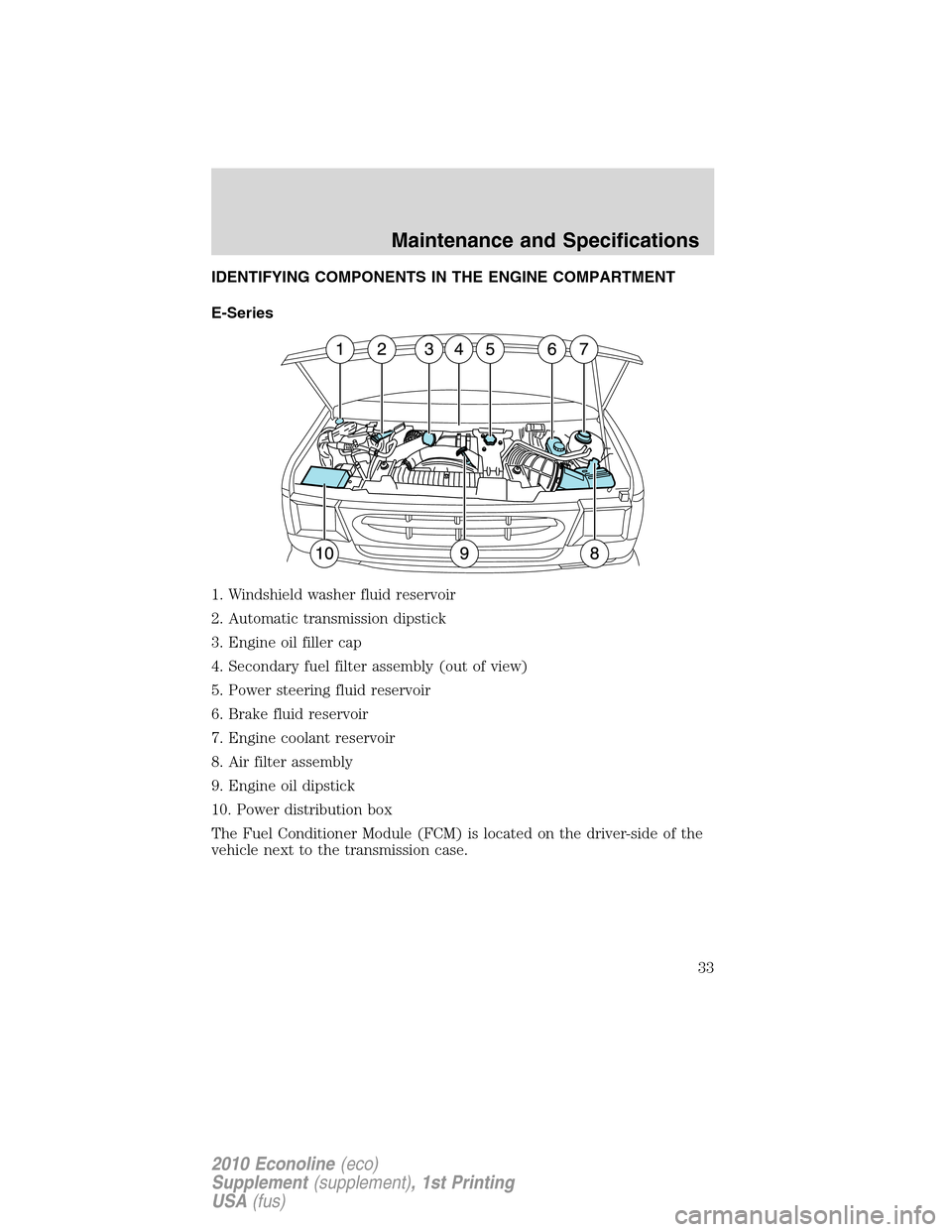
IDENTIFYING COMPONENTS IN THE ENGINE COMPARTMENT
E-Series
1. Windshield washer fluid reservoir
2. Automatic transmission dipstick
3. Engine oil filler cap
4. Secondary fuel filter assembly (out of view)
5. Power steering fluid reservoir
6. Brake fluid reservoir
7. Engine coolant reservoir
8. Air filter assembly
9. Engine oil dipstick
10. Power distribution box
The Fuel Conditioner Module (FCM) is located on the driver-side of the
vehicle next to the transmission case.
Maintenance and Specifications
33
2010 Econoline(eco)
Supplement(supplement), 1st Printing
USA(fus)
Page 39 of 104
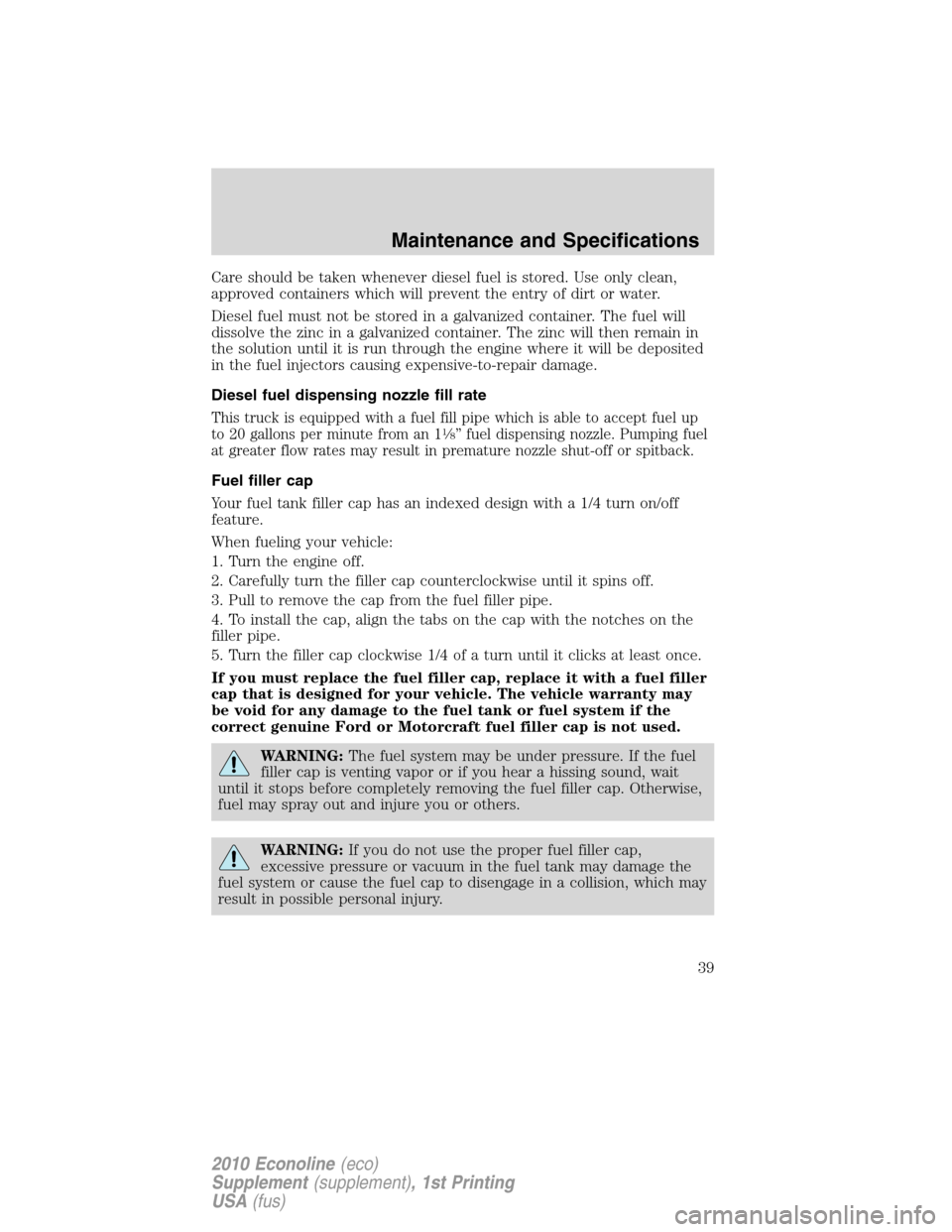
Care should be taken whenever diesel fuel is stored. Use only clean,
approved containers which will prevent the entry of dirt or water.
Diesel fuel must not be stored in a galvanized container. The fuel will
dissolve the zinc in a galvanized container. The zinc will then remain in
the solution until it is run through the engine where it will be deposited
in the fuel injectors causing expensive-to-repair damage.
Diesel fuel dispensing nozzle fill rate
This truck is equipped with a fuel fill pipe which is able to accept fuel up
to 20 gallons per minute from an 11�8” fuel dispensing nozzle. Pumping fuel
at greater flow rates may result in premature nozzle shut-off or spitback.
Fuel filler cap
Your fuel tank filler cap has an indexed design with a 1/4 turn on/off
feature.
When fueling your vehicle:
1. Turn the engine off.
2. Carefully turn the filler cap counterclockwise until it spins off.
3. Pull to remove the cap from the fuel filler pipe.
4. To install the cap, align the tabs on the cap with the notches on the
filler pipe.
5. Turn the filler cap clockwise 1/4 of a turn until it clicks at least once.
If you must replace the fuel filler cap, replace it with a fuel filler
cap that is designed for your vehicle. The vehicle warranty may
be void for any damage to the fuel tank or fuel system if the
correct genuine Ford or Motorcraft fuel filler cap is not used.
WARNING:The fuel system may be under pressure. If the fuel
filler cap is venting vapor or if you hear a hissing sound, wait
until it stops before completely removing the fuel filler cap. Otherwise,
fuel may spray out and injure you or others.
WARNING:If you do not use the proper fuel filler cap,
excessive pressure or vacuum in the fuel tank may damage the
fuel system or cause the fuel cap to disengage in a collision, which may
result in possible personal injury.
Maintenance and Specifications
39
2010 Econoline(eco)
Supplement(supplement), 1st Printing
USA(fus)
Page 42 of 104
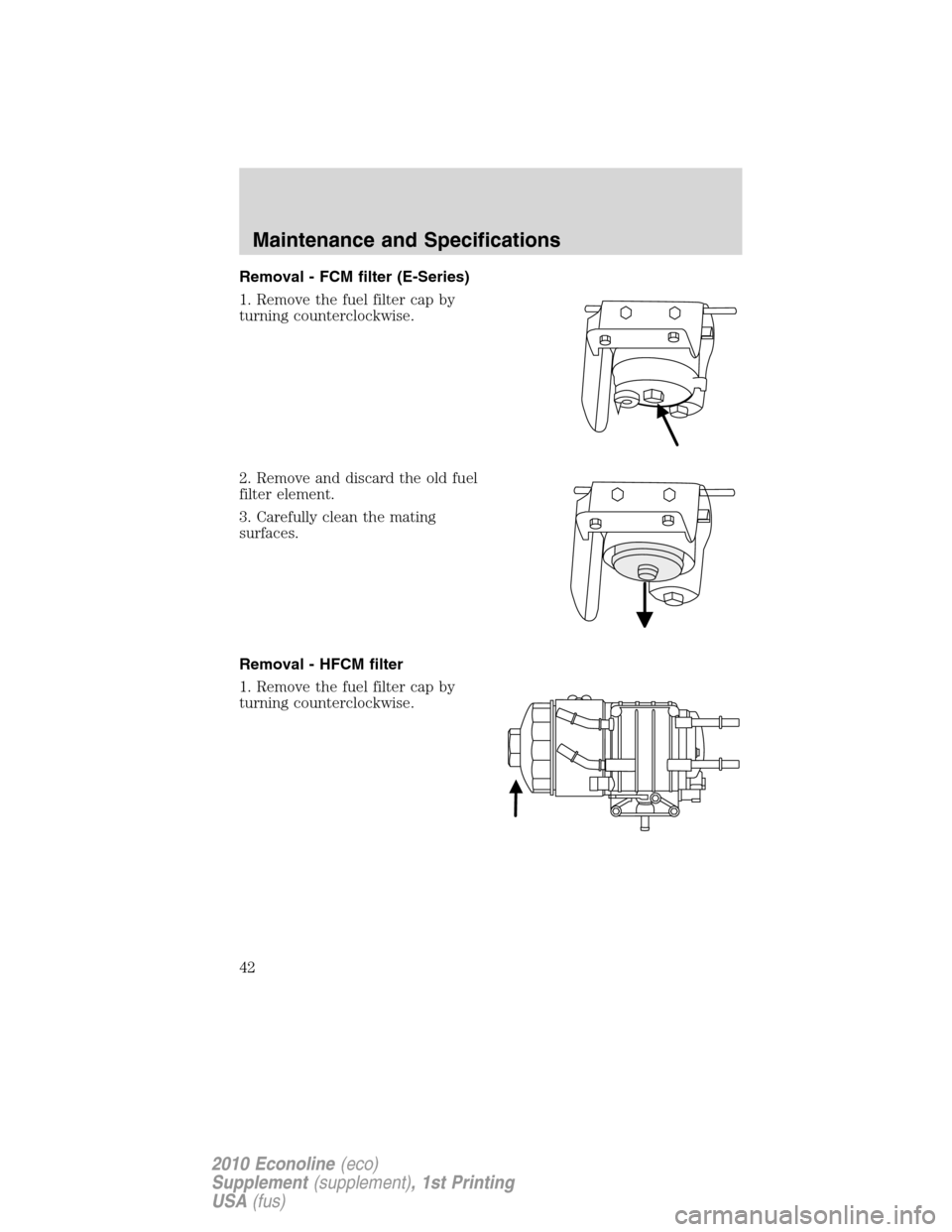
Removal - FCM filter (E-Series)
1. Remove the fuel filter cap by
turning counterclockwise.
2. Remove and discard the old fuel
filter element.
3. Carefully clean the mating
surfaces.
Removal - HFCM filter
1. Remove the fuel filter cap by
turning counterclockwise.
Maintenance and Specifications
42
2010 Econoline(eco)
Supplement(supplement), 1st Printing
USA(fus)
Page 43 of 104
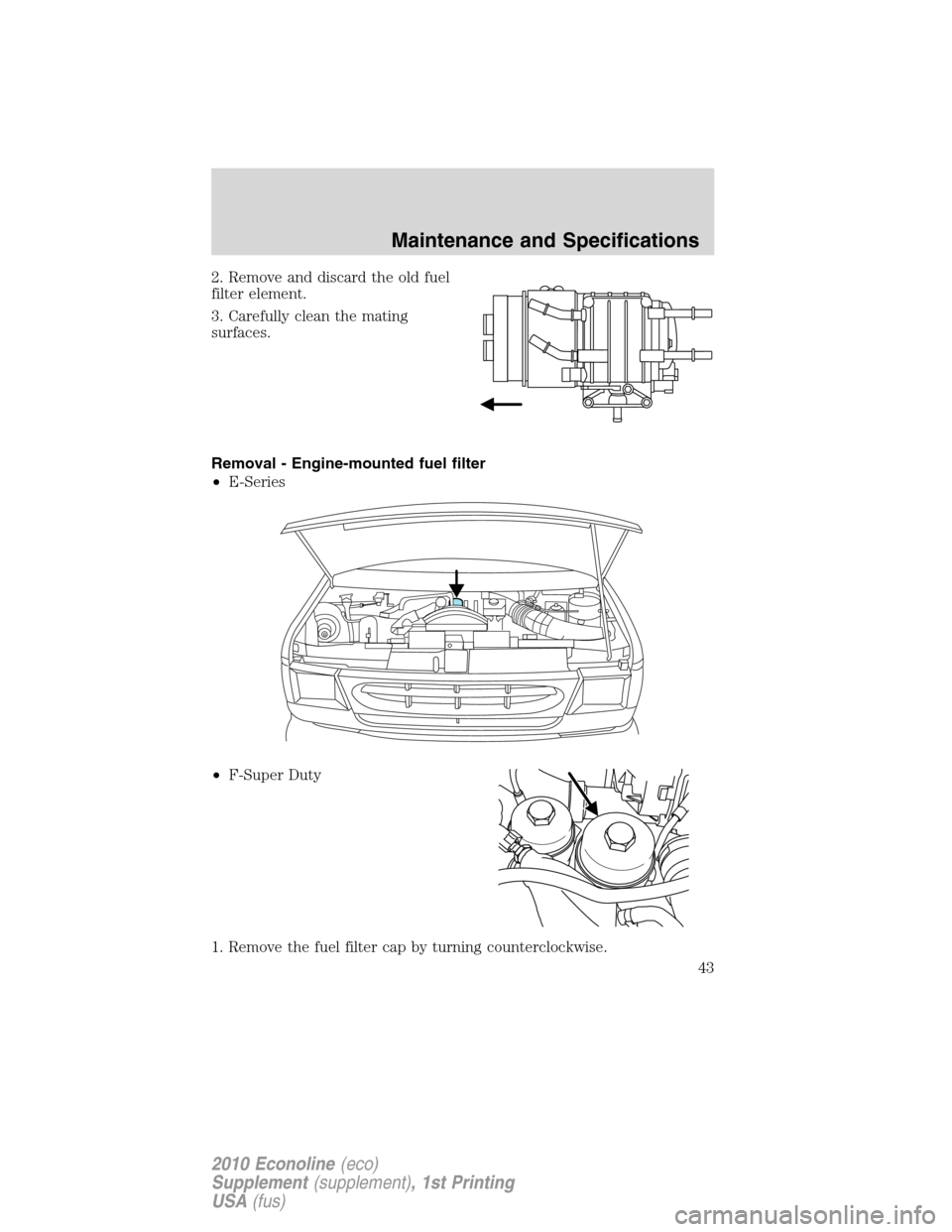
2. Remove and discard the old fuel
filter element.
3. Carefully clean the mating
surfaces.
Removal - Engine-mounted fuel filter
•E-Series
•F-Super Duty
1. Remove the fuel filter cap by turning counterclockwise.
Maintenance and Specifications
43
2010 Econoline(eco)
Supplement(supplement), 1st Printing
USA(fus)
Page 44 of 104
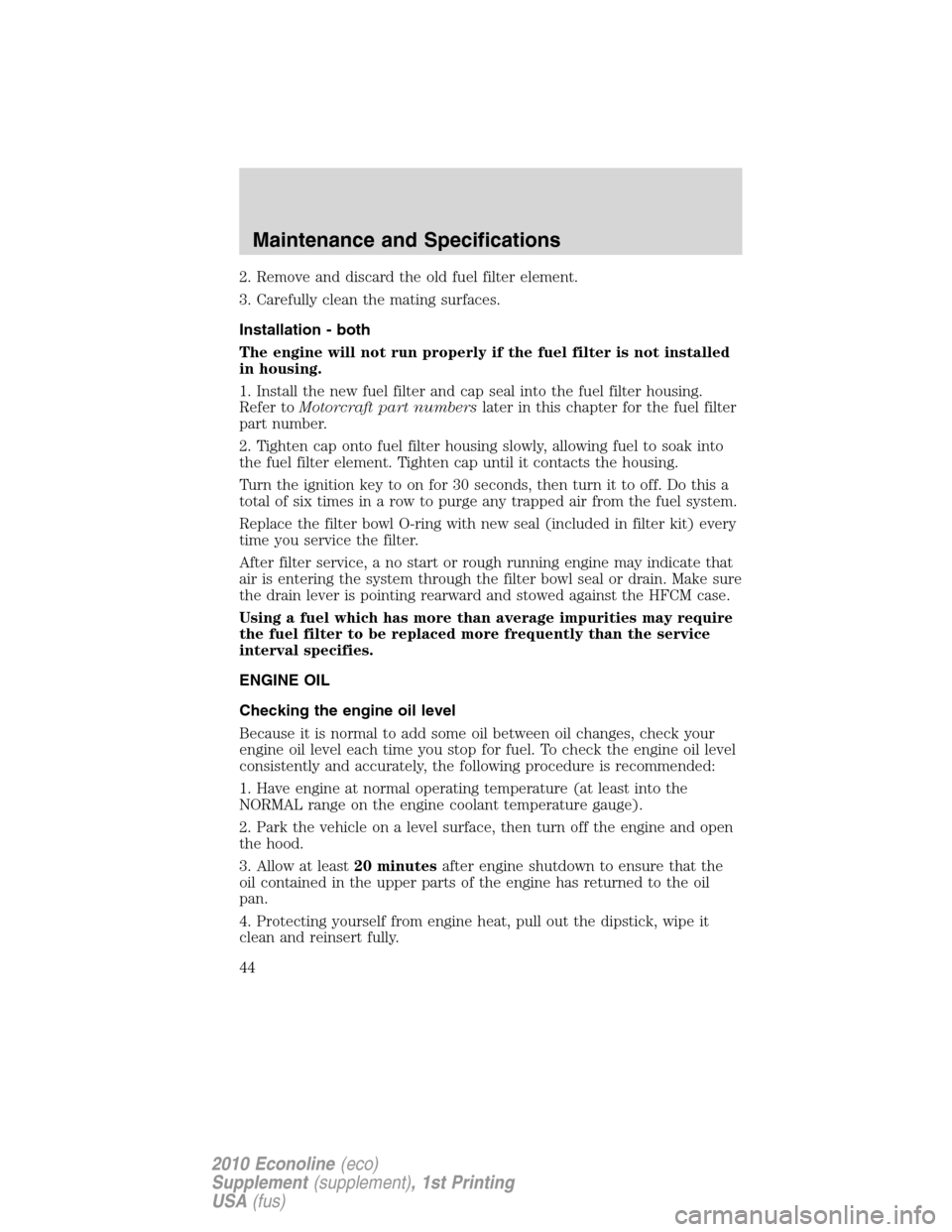
2. Remove and discard the old fuel filter element.
3. Carefully clean the mating surfaces.
Installation - both
The engine will not run properly if the fuel filter is not installed
in housing.
1. Install the new fuel filter and cap seal into the fuel filter housing.
Refer toMotorcraft part numberslater in this chapter for the fuel filter
part number.
2. Tighten cap onto fuel filter housing slowly, allowing fuel to soak into
the fuel filter element. Tighten cap until it contacts the housing.
Turn the ignition key to on for 30 seconds, then turn it to off. Do this a
total of six times in a row to purge any trapped air from the fuel system.
Replace the filter bowl O-ring with new seal (included in filter kit) every
time you service the filter.
After filter service, a no start or rough running engine may indicate that
air is entering the system through the filter bowl seal or drain. Make sure
the drain lever is pointing rearward and stowed against the HFCM case.
Using a fuel which has more than average impurities may require
the fuel filter to be replaced more frequently than the service
interval specifies.
ENGINE OIL
Checking the engine oil level
Because it is normal to add some oil between oil changes, check your
engine oil level each time you stop for fuel. To check the engine oil level
consistently and accurately, the following procedure is recommended:
1. Have engine at normal operating temperature (at least into the
NORMAL range on the engine coolant temperature gauge).
2. Park the vehicle on a level surface, then turn off the engine and open
the hood.
3. Allow at least20 minutesafter engine shutdown to ensure that the
oil contained in the upper parts of the engine has returned to the oil
pan.
4. Protecting yourself from engine heat, pull out the dipstick, wipe it
clean and reinsert fully.
Maintenance and Specifications
44
2010 Econoline(eco)
Supplement(supplement), 1st Printing
USA(fus)
Page 59 of 104
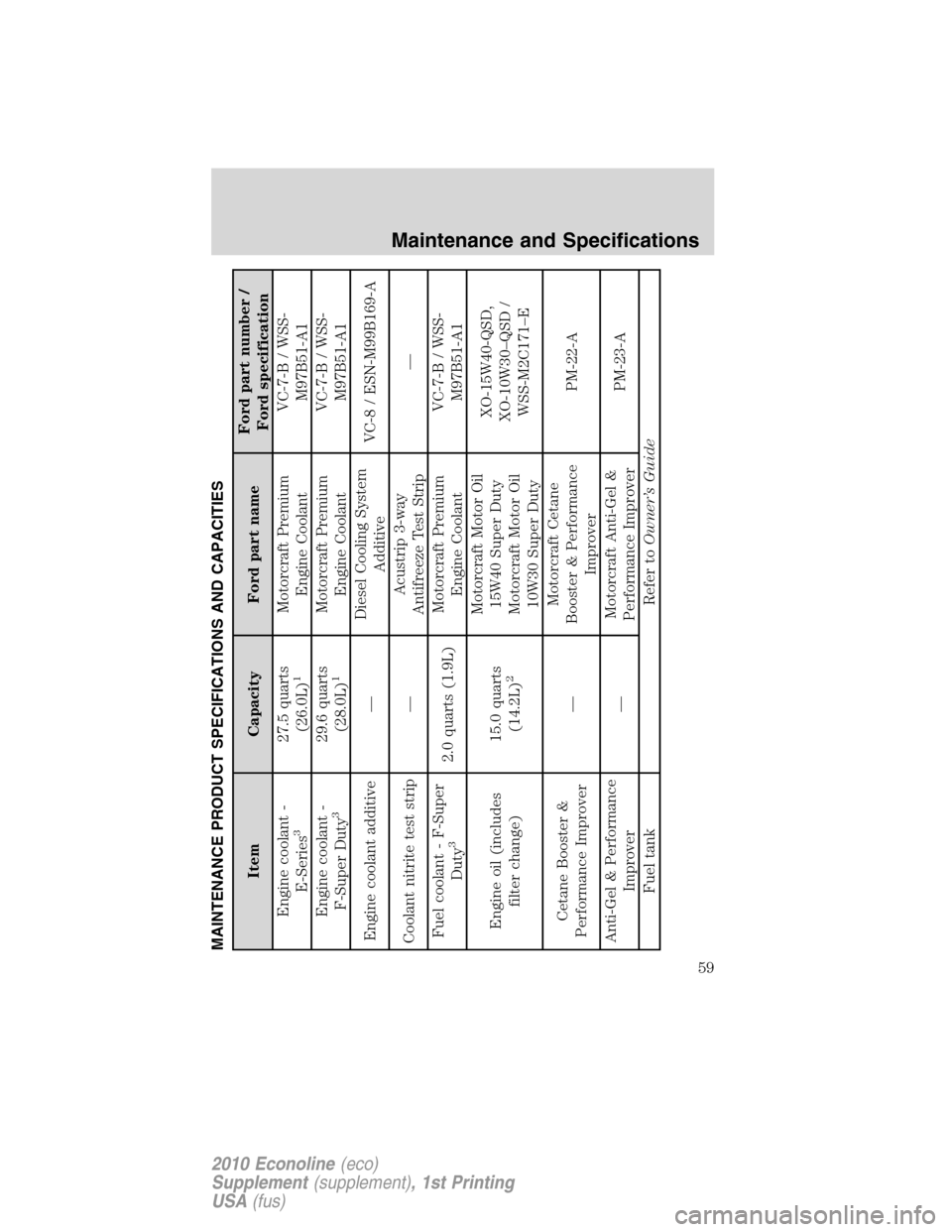
MAINTENANCE PRODUCT SPECIFICATIONS AND CAPACITIES
Item Capacity Ford part nameFord part number /
Ford specification
Engine coolant -
E-Series
3
27.5 quarts
(26.0L)
1
Motorcraft Premium
Engine CoolantVC-7-B / WSS-
M97B51-A1
Engine coolant -
F-Super Duty
3
29.6 quarts
(28.0L)
1
Motorcraft Premium
Engine CoolantVC-7-B / WSS-
M97B51-A1
Engine coolant additive —Diesel Cooling System
AdditiveVC-8 / ESN-M99B169-A
Coolant nitrite test strip —Acustrip 3-way
Antifreeze Test Strip—
Fuel coolant - F-Super
Duty
3
2.0 quarts (1.9L)Motorcraft Premium
Engine CoolantVC-7-B / WSS-
M97B51-A1
Engine oil (includes
filter change)15.0 quarts
(14.2L)
2
Motorcraft Motor Oil
15W40 Super Duty
Motorcraft Motor Oil
10W30 Super DutyXO-15W40-QSD,
XO-10W30–QSD /
WSS-M2C171–E
Cetane Booster &
Performance Improver—Motorcraft Cetane
Booster & Performance
ImproverPM-22-A
Anti-Gel & Performance
Improver—Motorcraft Anti-Gel &
Performance ImproverPM-23-A
Fuel tank Refer toOwner’s Guide
Maintenance and Specifications
59
2010 Econoline(eco)
Supplement(supplement), 1st Printing
USA(fus)
Page 64 of 104
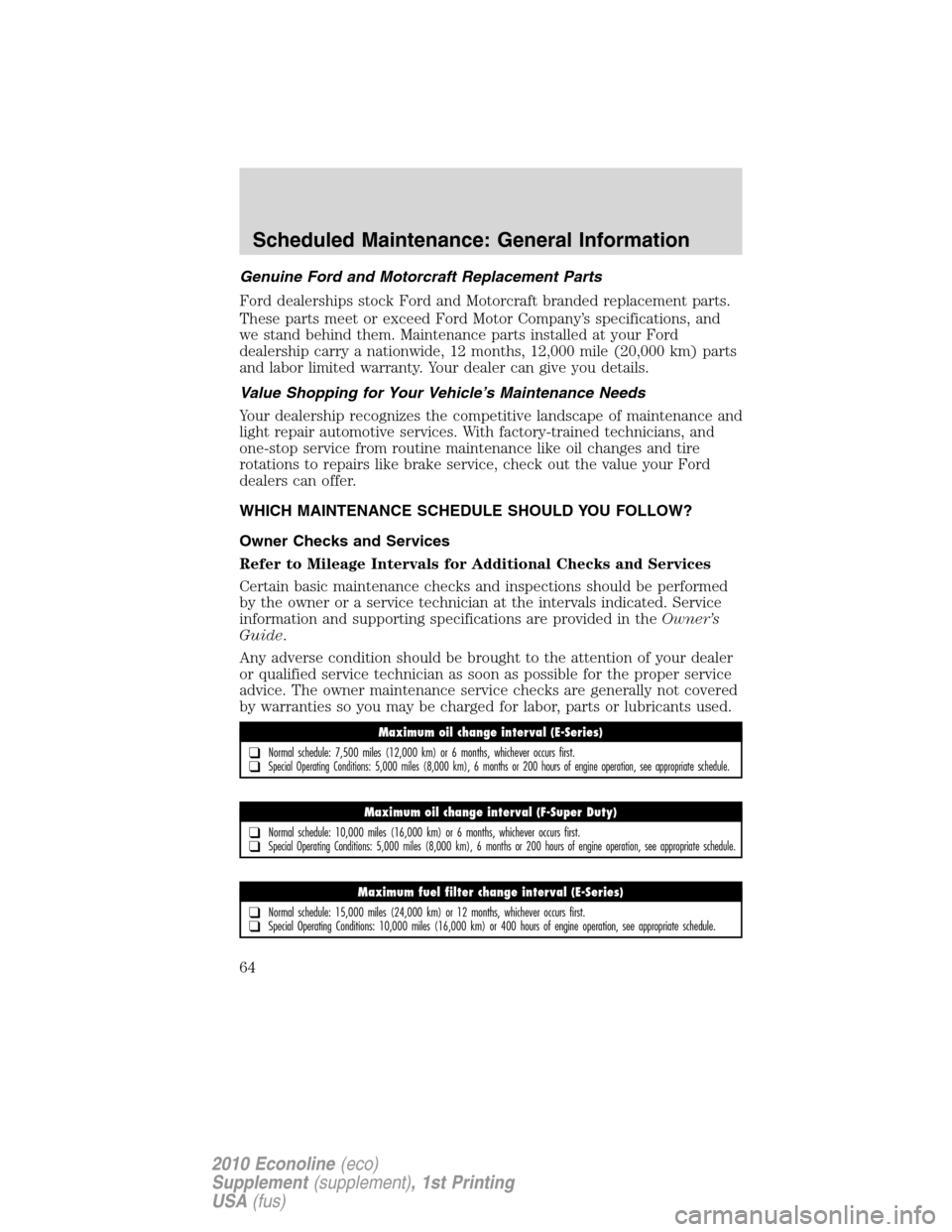
Genuine Ford and Motorcraft Replacement Parts
Ford dealerships stock Ford and Motorcraft branded replacement parts.
These parts meet or exceed Ford Motor Company’s specifications, and
we stand behind them. Maintenance parts installed at your Ford
dealership carry a nationwide, 12 months, 12,000 mile (20,000 km) parts
and labor limited warranty. Your dealer can give you details.
Value Shopping for Your Vehicle’s Maintenance Needs
Your dealership recognizes the competitive landscape of maintenance and
light repair automotive services. With factory-trained technicians, and
one-stop service from routine maintenance like oil changes and tire
rotations to repairs like brake service, check out the value your Ford
dealers can offer.
WHICH MAINTENANCE SCHEDULE SHOULD YOU FOLLOW?
Owner Checks and Services
Refer to Mileage Intervals for Additional Checks and Services
Certain basic maintenance checks and inspections should be performed
by the owner or a service technician at the intervals indicated. Service
information and supporting specifications are provided in theOwner’s
Guide.
Any adverse condition should be brought to the attention of your dealer
or qualified service technician as soon as possible for the proper service
advice. The owner maintenance service checks are generally not covered
by warranties so you may be charged for labor, parts or lubricants used.
Maximum oil change interval (E-Series)
❑Normal schedule: 7,500 miles (12,000 km) or 6 months, whichever occurs first.❑Special Operating Conditions: 5,000 miles (8,000 km), 6 months or 200 hours of engine operation, see appropriate schedule.
Maximum oil change interval (F-Super Duty)
❑Normal schedule: 10,000 miles (16,000 km) or 6 months, whichever occurs first.❑Special Operating Conditions: 5,000 miles (8,000 km), 6 months or 200 hours of engine operation, see appropriate schedule.
Maximum fuel filter change interval (E-Series)
❑Normal schedule: 15,000 miles (24,000 km) or 12 months, whichever occurs first.❑Special Operating Conditions: 10,000 miles (16,000 km) or 400 hours of engine operation, see appropriate schedule.
Scheduled Maintenance: General Information
64
2010 Econoline(eco)
Supplement(supplement), 1st Printing
USA(fus)